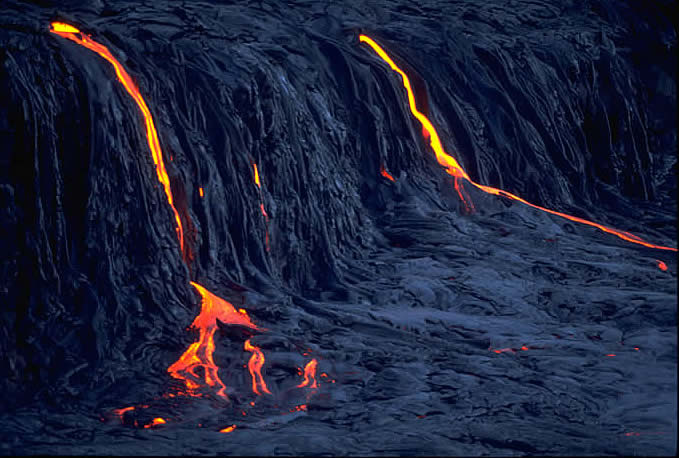|
Hawaiian
Genesis
Travel Feature - Boston Sunday Globe
By Sam Low
 |
Jealous, moody, easily enraged, the
goddess Pele is the primal force that has thrust the Hawaiian islands
from the sea. She has fashioned the blasted moonscape on either side of
us as we take Chain of Craters Road through Hawaii's Volcanoes National
Park. A gentle fog slicks a recent lava flow, creating a shimmering stone
pudding that vibrates with her power. Here and there, a few spindly trees
force their roots deep into tiny crevices in the lava. Older flows are
covered with moss.
My cousin Kim Hart and I have come to Hawaii to discover and photograph
the forces - natural and human - that have created the "big island." Kim
is an American photographer based in Norway. I am a television producer
and writer. Although I live in Boston, I am part Hawaiian - my father
and grandfather were born in the islands. This trip is a return to my
roots.
Descending toward the coast, Chain of Craters road bends in a tight switchback.
The ocean swings wide before us, a shimmering blanket to the vanishing
point. In spontaneous awe, we exclaim aloud. We stop. The road snakes
down the Holei Pali fault scarp and disappears suddenly behind two pillars
of smoke rising majestically where active lava flows meet the ocean.
At a National Park Service roadblock we pull over and unload our cameras.
A Ranger warns us of the dangers ahead:
"Don't wander into the active flows!" he tells us. "There are lava tubes
that will give way beneath your weight. Your next stop will be a bath
in molten lava. And be careful near the edge of the lava beds. The cliff
fractured and a tourist plunged a hundred feet into the ocean. We never
found him."
We have arrived at the Golden Hour, the time just before sunset when the
coast is painted in a gentle yellow sheen. Ribbons of lava are revealed
in the gathering darkness. A scarlet stream flows down a volcanic delta
and cascades into the surging ocean. Clouds of steam obscure its glow.
We are surrounded by hundreds of tourists but they are stunned to silence
by the awesome natural spectacle. I hear a muffled popping like a package
of Chinese firecrackers exploding in the distance - the sound of molten
lava as it is extinguished by the ocean's embrace. Kanaloa, god of the
sea, and Pele, goddess of fire, are mating in an ancient ritual of island
building and wearing away.
Geologists know that Pele is the primal engine of our planet. Dozens of
miles beneath where we sit watching her fireworks, is a "hot spot" - a
point of intense thermal energy. As the abyssal ocean floor rides the
Pacific plate to the northwest, a few inches a decade, it passes over
the hot spot. Molten magma flows upwards to form the Hawaiian island chain.
Kauai formed five million years ago. The plate carried it northwest. Oahu
slid over the hot spot and coalesced, then Molokai, Lanai, Maui, and Kahoolawe.
Hawaii is still forming right in front of us. Because Kauai is older,
it's landscape is deeply eroded by tropical rains. Hawaii, the youngest,
retains its voluptuous curves.
The next day, we ride the curve of Mauna Loa on Highway 11, descending
the ancient volcano's gentle arc toward the district of Puna. We follow
route 130 until it dead ends where glistening mounds of lava have pushed
into the sea to form a new coastline. Beneath are dozens of cement foundations,
all that remains of tract houses built in harm's way only a few decades
ago.
Puna is home to a human tide that washed over the islands in the late
sixties. Pahoa, once a sugar plantation town, now bustles with New Agers.
Former Japanese storefronts are emblazoned with signs that advertise natural
foods, Zen therapists and paraphernalia for the enjoyment of marijuana.
A few aging hippies with long flowing beards stare at us as we drive past.
Kim and I move on, seeking the remnants of an older Hawaii.
We follow a narrow road, bordered by thick stone walls. I imagine they
were built by the retainers of ancient Hawaiian Kings or the hired labor
of long gone plantation barons. On each side, the land rises to the height
of a tall man, like the roads in Wales that run below high hedge rows.
Perhaps, as in Wales, this road has been dug into the earth by centuries
of traffic. Suddenly, we enter a natural cathedral of trees towering a
hundred feet to a canopy of delicate green lace. Looking up, we see a
river of light where the leaves have touched each other and have been
worn away as they sway in the constant Trade Winds. We are dwarfed by
an explosion of leaves - spear shaped, rounded, lacy. I imagine the dense
growth conceals the ruins of a magnificent planter's house, its gardens
lost in creepers, its verandah fallen in upon itself. There is the aroma
of moist growing things, a lingering smell like that of rotting coffee
grounds.
That night, we drive up the northern flank of Mauna Loa toward the town
of Waimea. The sun sets ahead. A low pressure area has passed over the
island, bringing steady northern winds, cleaning the air. Against the
sun's glow, windbreaks of Ohia trees fan bare limbs against the sky. Cattle
stand on small rounded hills in crisp silhouettes. Darkness sets in quickly.
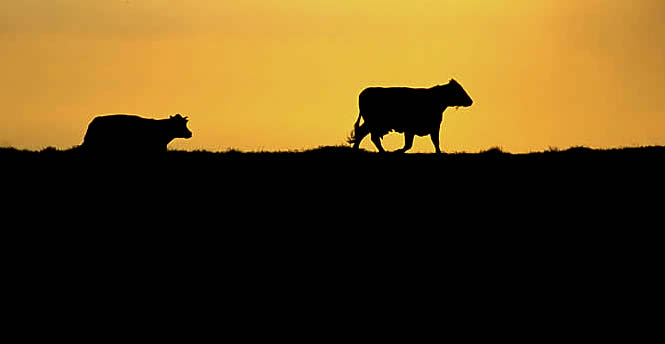
Waimea sits in the saddle between Mauna Kea to the south and the Kohala
Mountains to the north. This is the home of the world famous Parker Ranch,
the largest family-held cattle outfit in the world. The ranch was founded
by my great-great grandfather, John Palmer Parker, a native of Newton,
Massachusetts. In 1815, he was among the first white men to settle in
Hawaii.
Twenty-three years before Parker's arrival, King Kamehameha the first
received a gift of a bull and five cows from the British explorer Vancouver.
The king ordered that no-one touch them, under penalty of death, so they
would multiply. When Parker arrived, the mountains around Waimea teemed
with wild cattle, poising a threat to man and nature alike. Parker received
the sole privilege of hunting these cattle for hides and meat. After marrying
a royal chiefess, Kipikane, Parker built his home on the slopes of Mauna
Kea at the end of a horse trail, a few miles from Waimea.
"It was an enchanting place, luxuriant with Hawaiian forest growth," wrote
my great Aunt, Mary Low, who grew up on the Parker homestead. "They loved
the Mamane, the Maile, the Hapu'u tree ferns, the many birds of yellow,
green, and red and the black ones with yellow tuft-feathers, singing and
flying about. Kipikane wanted to live there immediately... 'At once! At
once' as she said happily. In a couple of days there were two new hale
pili (grass houses) being erected by her numerous retainers."
The hale pili were soon replaced by a proper New England salt box home
which Parker finished off with a gleaming interior sheath of Hawaiian
Koa, a wood like Mahogany. The original house still stands where it was
built, but a more accessible replica is at Pu'u'opelo, in Waimea, which
is open to visitors. Kim and I visited Pu'u'opelo and the nearby Parker
Ranch Museum in Waimea Town to piece together the history of this famous
family.
Parker became a renowned hunter of wild cattle. Roaming the Kohala mountains
and ascending the slopes of Mauna Kea with his percussion cap musket,
he built his first fortune by selling the meat to visiting whale ships
and the hides to markets as far away as Boston. Later, he purchased land
for a ranch and imported Mexican vaqueros to teach Hawaiians to ride and
rope. Today, Hawaiian cowboys are called Paniolos which is a "Hawaiianization"
of the Spanish word for Spain - Espanol. After Parker's death in 1868,
his children continued to grow the ranch. Today it sprawls over 227,000
acres of the finest grazing land in Hawaii.
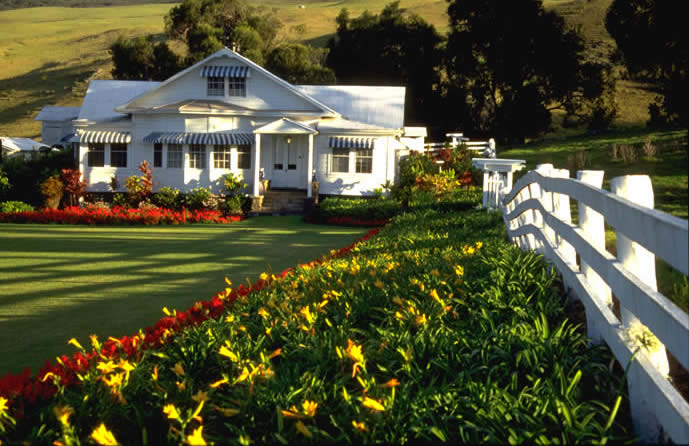
Surrounding Parker Ranch are many smaller ones with poetic Hawaiian names
- Huehue (overflowing again and again), Kahua (the foundation), and the
ranch my grandfather started in 1884, Puuwaawaa (peak with gulches). On
Thursday, we take the high road over the Kohala Mountains through ranch
lands shrouded in mist called Vaug. It's caused when the clouds of volcanic
steam from Mauna Loa float into these mountains - the same clouds we had
seen a few days earlier rising over Chain of Craters Road. Suddenly the
sun breaks through. The pastures glow with a green so brilliant that it
seems the light must be coming from deep beneath the earth.
Ahead, we see cars and pickup trucks parked by the roadside. We stop.
Cowboys are branding cattle. We join a crowd gathered around a large fenced
paddock to watch flames leaping off the calves' haunches as red-hot branding
irons are applied. The aroma of burning flesh drifts over us. Suddenly
a calf breaks free and races for the open grazing land. Two cowboys riding
lathered horses gallop in pursuit. A lariat is unfurled, arcs through
the air, and neatly encircles the calf's hind legs. The cow pony backs
on its haunches. A husky Hawaiian wrestles the calf to the ground and
a team swarms over it. My grandfather, "Rawhide Ben" Low, described just
such a scene in his memoirs - a scene that took place a century ago:
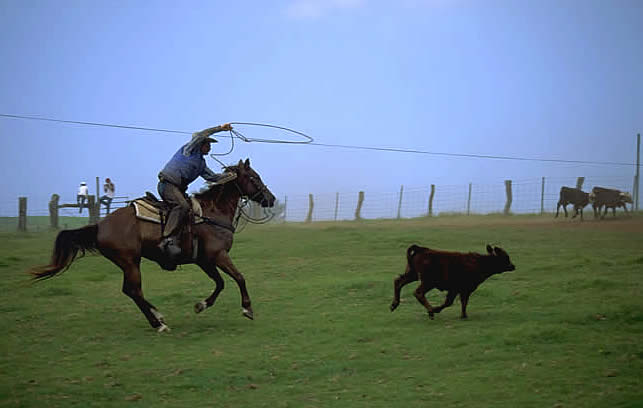
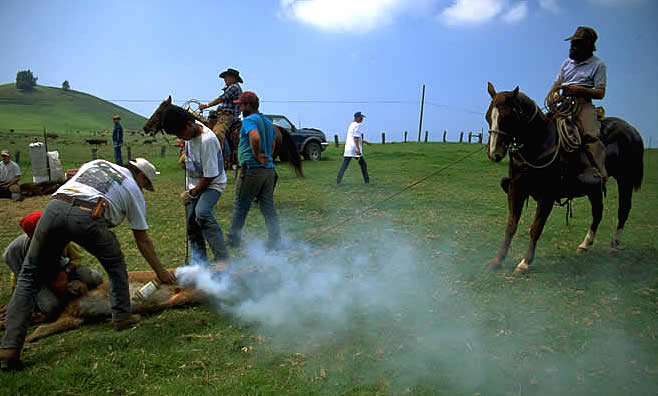
"I have seen as many as two hundred men take part in the big Parker Ranch
drives. There are many others who sit atop the corral walls to watch when
the branding begins. Only expert riders and ropers can control the calves
efficiently and tenderfeet would only be in the way or add danger to the
cowboys and themselves. Not only are the cowboys and horses carefully
selected, but also the crew handling the throwing of calves, tending the
fires and the branding irons. The branding men must be strong and fast
and know their business of burning just right. Several others must be
expert in castrating and ear marking for these jobs require skill and
precision."
During a rest break we meet the owners of the ranch, Angie and Pono Von
Holt. Angie tells us that their ranch, Pono Holo, is small by Hawaiian
standards, 10,000 acres with about 7,000 head of cattle. Even so, its
a big business. The Von Holts fatten the calves here during the wet Winter
months when the grass is tall and verdant. In the summer, they are shipped
to another Von Holt ranch in Oregon for final fattening, then to the slaughter
houses in Chicago.
Driving home that night we stop just above Waimea to watch the sun set.
In the distance, Parker Ranch grazing lands sweep gracefully up toward
the summit of Mauna Kea over smoothed low hills punctuated by cinder cones.
As the sun sinks lower, giant cumulus clouds heave their bellies over
the summit. Emerald green paddocks stretch from about half way up Mauna
Kea right down to the shimmering ocean 15 miles away. The only sound is
the gentle bellowing of cattle.
It is hard to imagine what this scene must have looked like only a century
ago when the slopes of Mauna Kea were covered by native forests. That
night I thumb through the faded pages of my grandfather's manuscript to
find his description, written in 1939:
"As I sit here and write these few lines, it brings back memories of that
magnificent growth of stately trees and dense growth of ferns, so thick
that it was a physical impossibility for man or beast to penetrate. The
whole forest was a living swamp, ponds of water everywhere, wild ducks
by the thousands. This dense forest extended from the 5,000 feet elevation
to 3 miles from the coast and hardly a stream that has an outlet to the
ocean was ever known to be dry. And just consider that this forest has
disappeared within my memory and not a log or a tree trunk of 4 or 5 feet
in diameter can be seen, all disappeared into eternity, ashes, and the
memory of the old timers, and I am one of the last. Since the introduction
of cattle, goats, sheep and hogs with no provision of safeguarding the
forest by fencing, that forest has disappeared in the astounding short
time of 60 years."
The next morning, Kim and I watch the sun rise from the verandah of our
rented house. Mauna Kea sweeps in a graceful arc from the sea to an altitude
of 13,600 feet. We decide to find out what the view is like from its peak.
The summit road curves through unfenced Parker Ranch range land where
we are on the lookout for wandering cattle. At about 8500 feet above sea
level, the road works through low hanging clouds. The ascent is steep.
The air thins. We feel light headed. At 11,000 feet, we break through
the clouds into clear blue sky. Ahead, the road to the summit of Mauna
Kea ascends so steeply I wonder if our car will make it.
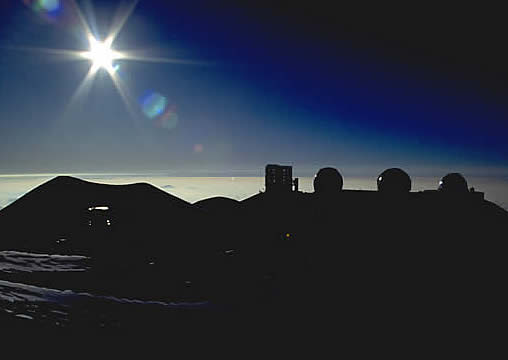
At the road's end, about 13,000 feet above sea level, crisp geometric
shapes rise into the azure sky - observatories that search deep space
through the clear air at this high altitude. In the thin air and gathering
cold, I find that I must move slowly or I will be winded. The winds here
can reach a 100 miles an hour, but today they are light and pleasant.
By six P.M., the sun sinks quickly toward the cloud layer, painting the
observatories a gentle pink. The cold seeps in under our parkas. To the
north-west, Maui floats in a sea of cotton. As the sun drops, the horizon
becomes blood red and the sky deep purple. Giant slits in the observatories
open - the domes swivel to their assigned area of deep space. For the
astronomers it is time to go to work. For us, it's time to go home.
I have been warned not to ride the brakes during the steep descent, so
I pump them when we reach twenty miles an hour. Darkness envelopes us
and for a time we seem to be flying through a sea of diamonds. Never before
have we seen the Milky Way so clearly. In low gear, it takes 45 minutes
to make the 8 mile descent.
Not knowing the danger, we made the trip to the summit in a rented economy
car. Later, I read the following in a Guidebook: "Don't even think about
driving an ordinary passenger car all the way up Mauna Kea, even in the
best of weather. ...You can't gear an ordinary passenger car down far
enough to descend the steep road without riding the brakes. You'd almost
certainly burn out the brakes, lose control of the car, and join the ghosts
of others who've lost it on that road. It is possible to drive up and
back if you rent a suitable 4WD vehicle."
On Saturday we take the shore road along the Kawaihae Coast toward Mahukona
Harbor. The land on both sides seems arid, useless for human habitation.
But from the road we see stone platforms which mark the place of ancient
temples or heiau. I remember once flying over this landscape in a helicopter.
In the slanting early morning light I saw thin spidery lines, arrow straight,
stipple the land below - all that remains of stone walls built by ancient
Hawaiian farmers. Perhaps the early Hawaiians knew how to cultivate crops
in a dry environment, but more likely, before the ravages of cattle and
sugar plantations, this place was once much wetter.
We turn down a one lane road toward Mahukona - once a port where cane
sugar was shipped to the mainland from thriving plantations. Today, all
that remains are foundations and rusted bits of metal.
"The labor in South America was cheaper and the land more valuable for
development than for farming," says Sonny Solomon, our guide for the afternoon.
We have come to Mahukona to visit a much earlier site, the Ko'a Holo Moana
heiau, a temple dedicated to the arts of Polynesian navigation. The first
Polynesian seafarers set out from Tonga to explore the vast Pacific Ocean
about 1300 BC, as the walls of Troy were falling to the Greeks. By the
time of Christ, they had discovered and settled most of the great Polynesian
triangle with the exception of the most remote islands of all - Hawaii.
Some archaeologists think that the first Polynesian canoes arrived at
South Point, the southernmost tip of the Big Island, about 1000 AD The
Navigators who guided those canoes were revered in ancient Hawaiian society.
Sonny and I scramble up a steep hill to the heiau which sits on a promontory
above a small bay.
"The ancient Hawaiians had a canoe anchored right there," Sonny tells
us, pointing to the bay, "and the student navigators slept on the canoe
to feel the movement of the waves which they would use as a natural compass
when they became full fledged navigators."
Today we know a great deal about this wayfinding art because of the voyages
of Hokule'a, a replica of an ancient Hawaiian canoe, which first retraced
the route between Hawaii and Tahiti in 1976. Sailing across 2200 miles
of open ocean, the canoe was guided by one of the last navigators to know
the signs written in waves and stars, Mau Piailug from the tiny Micronesian
atoll of Satawal. In 1981, I journeyed to Satawal to produce a PBS documentary
about Mau's seafaring skills. I sailed with him aboard his swift proa
which he fashioned without plans from the log of a breadfruit tree. At
night, in his darkened canoe house, he unfolded a woven pandanus mat before
me and placed 32 lumps of coral upon it to represent the rising and setting
points of the stars that define his "star compass." He taught me the direction
of ocean swells that he steered by when clouds obscured the sky. Mau allowed
me to enter a world in which writing, maps, sextants and compasses were
replaced by a knowledge of nature so profound that he could sail with
confidence anywhere in the world. Since then, Mau has taught young Hawaiians
to navigate in the traditional way and his students have sailed 45,000
miles aboard Hokule'a throughout the Pacific to kindle a new pride among
all Polynesians.

Ascending the hill at Mahukona, Sonny stops before a tall standing stone.
"That is Kanaloa," he says, "it's got to be because it's the nearest to
the sea."
Up-slope from Kanaloa is a platform of black volcanic rock dominated by
dozens of stone pillars radiating away in myriad directions. There are
many strong alignments - three pillars seem to march in the general direction
of Tahiti, others could be solstice markers. Sitting on the heiau, I imagine
a double hulled canoe at anchor in the bay. In the distance, another canoe
sets out with a class of navigator apprentices for a session at sea. For
these ancient mariners, the ocean was a road that joins Hawaii to Tahiti
and on to the Cook islands, to New Zealand, and to the thousand other
islands that make up the greater society of Polynesia.
On Sunday, our last day, we descend from Waimea along a road that drops
2500 feet to the tiny town of Puako on the South Kohala coast. Here, thirty
years ago, I remember driving a jeep down a one lane track to my family's
beach house at Paniao ( "place of swirling waters" ). In 1964, Paniao
was ten acres of lava, crab grass, and a shack blackened by decades of
salt spray where we lifted shutters to let the Trade Winds blow through
and lit kerosene lanterns at night. Today, the shack is gone. In its place,
a rock star and a local entrepreneur have built two majestic homes. Development
catapulted taxes so high that my family was forced to sell the land. Along
miles of coast, where fishing shacks once stood, Kim and I find palatial
homes. A small ocean front house lot costs a million dollars, or more.
Resorts spread golf courses over once barren lava beds. We drive on to
keep a scuba diving appointment at one of them.
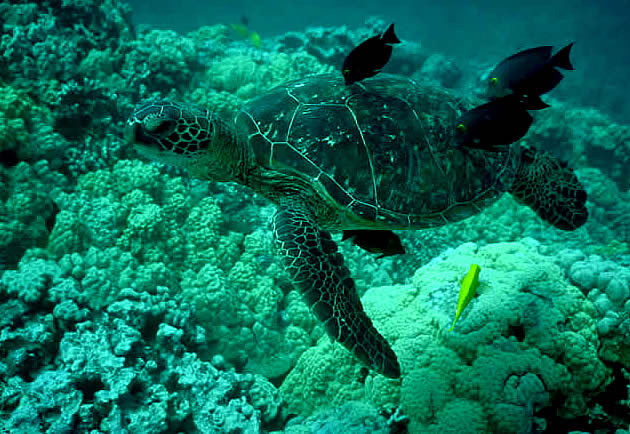
Anchored off an eroded lava flow, we slip beneath the ocean's surface
to a world that has escaped the forces of development, the domain of Kanaloa.
If Pele is fierce and hot, Kanaloa is gentle and cool. We hang suspended
over a reef, moving with the regular swell. Beneath us, a sea turtle is
tended by rainbow hued fish with lyric Hawaiian names, Lau'i-pala, Kihikihi
and Paku'iku'i. All around us, Kanaloa has reshaped the work of Pele to
his own artistic tastes, smoothing sharp edges of lava flows and adorning
them with coral. We swim through lava tubes, natural arches which formed
as the molten rock cooled. Later, as we bask in the bright sunlight, I
admire Kanaloa's shimmering surface. It is the ancient road that beckoned
Polynesians to feats of exploration that no other people have quite equaled.
Compared to them, the Greeks, our heroes of the dark ships, were timid
coast-huggers. Fearful of sailing at night, they beached their ships when
the sun set. The Polynesians welcomed darkness for the stars provided
a compass by which they steered their powerful canoes. Fifteen hundred
years before Europeans learned to fashion sea-going vessels staunch enough
to discover Hawaii, the Polynesians had explored and settled the entire
Pacific, one third of the earth's surface. Kanaloa provided the highway
- a deep human urge to explore carried the ancient Hawaiians across it.
Tomorrow, Kim will fly back to Norway and I will return to writing a book
about my Hawaiian grandfather, Rawhide Ben, and his cowboy world. In only
five days, we have managed to sample the Hawaiian genesis - the forces
that shaped this island state - the deep pyrotechnics of the earth's core
that are expressed all around us; the first Hawaiian settlers who built
their settlements to blend with nature so well that traces of them have
virtually disappeared; my New England ancestors who realized profit from
cattle and sugar, forever changing the face of the island. And at the
very pinnacle of Mauna Kea we found men and women who imagine voyages
to distant stars and plot the maps that may someday guide astronauts to
new settlements.
As I thought of these modern explorers, I realized that they will pilot
their course by the same stars that once guided Polynesian mariners as
they crossed the vast and heaving road of Kanaloa - to Hawaii.
|

